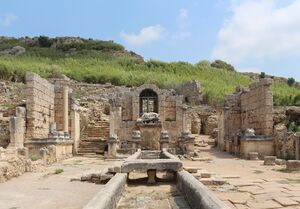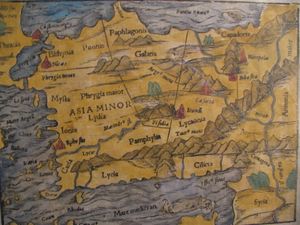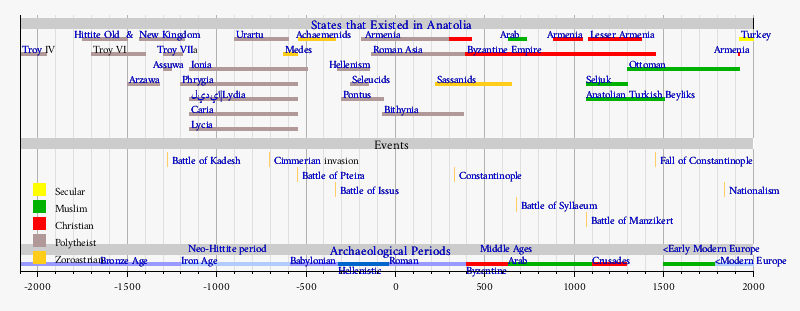پامفيليا
| Pamphylia (Παμφυλία) | |
|---|---|
| منطقة قديمة في الأناضول | |
 أطلال الشارع الرئيسي في پرگا، عاصمة پامفيليا | |
| الموقع | جنوب الأناضول |
| الدولة الموجودة: | - |
| الأمم | Pamphylians, Pisidians, Greeks |
| العواصم التاريخية | پرگا، أتـّالِيا |
| مقاطعة رومانية | پامفيليا |
 الأناضول/آسيا الصغرى في العصر اليوناني-الروماني. المناطق الكلاسيكية، بما فيها پامفيليا، والمستوطناتها الرئيسية فيها. | |
پامفيليا (Pamphylia ؛ باليونانية قديمة: Παμφυλία, Pamphylía, modern pronunciation Pamfylía /pæmˈfɪliə/) was a region in the south of Asia Minor, between Lycia and Cilicia, extending from the Mediterranean to Mount Taurus (all in modern-day Antalya province, Turkey). It was bounded on the north by Pisidia and was therefore a country of small extent, having a coast-line of only about 120 km (75 miles) with a breadth of about 50 km (30 miles). Under the Roman administration the term Pamphylia was extended so as to include Pisidia and the whole tract up to the frontiers of Phrygia and Lycaonia, and in this wider sense it is employed by Ptolemy.[1]
الاسم
The name Pamphylia comes from the Greek Παμφυλία,[2] itself from باليونانية قديمة: πάμφυλος (pamphylos), literally "of mingled tribes or races",[3] a compound of πᾶν (pan), neuter of πᾶς (pas) "all"[4] + φυλή (phylē), "race, tribe".[5] Herodotus derived its etymology from a Dorian tribe, the Pamphyloi (Πάμφυλοι), who were said to have colonized the region.[6] The tribe, in turn, was said to be named after Pamphylos (Greek: Πάμφυλος), son of Aigimios.[7][8]
أصول الپامفيليين
According to Encyclopædia Britannica, the Pamphylians were “a mixture of aboriginal inhabitants, immigrant Cilicians (باليونانية: Κίλικες) and Greeks”.[9] However, Herodotus and Strabo record that the Pamphylians were descended from Greeks who came with Calchas and Amphilochos after the Trojan War.[10] Additionally, Pausanias states that they were a Greek race.[11] Theopompus, as well, informs us that Pamphylia was inhabited by Greeks.[12] Some modern scholars suggest that they migrated to Pamphylia from Arcadia and generally the Peloponnese in the 12th century BC.[13] The significance of the Greek contribution to the origin of the Pamphylians can be attested alike by tradition and archaeology,[14] and Pamphylia can be considered a Greek country from the early Iron Age until the early Middle Ages.[15]
There can be little doubt that the Pamphylians and Pisidians were the same people, though the former had received colonies from Greece and other lands, and from this cause, combined with the greater fertility of their territory, had become more civilized than their neighbours in the interior.[بحاجة لمصدر] But the distinction between the two seems to have been established at an early period. Herodotus, who does not mention the Pisidians, enumerates the Pamphylians among the nations of Asia Minor, while Ephorus mentions them both, correctly including the one among the nations on the coast, the other among those of the interior.[1]
A number of scholars have distinguished in the Pamphylian dialect important isoglosses with both Arcadian and Cypriot (Arcadocypriot Greek) which allow them to be studied together with the group of dialects sometimes referred to as Achaean since it was settled not only by Achaean tribes but also colonists from other Greek-speaking regions, Dorians and Aeolians.[16] The legend related by Herodotus and Strabo, which ascribed the origin of the Pamphylians to a colony led into their country by Amphilochus and Calchas after the Trojan War, is merely a characteristic myth.[1]
التاريخ
A treaty between the Hittite Great King Tudḫaliya IV and his vassal, the king of Tarḫuntašša, defined the latter's western border at the city "Parha" and the "Kastaraya River".[17] The river is assumed to be the classical Kestros (Turkish Aksu Çayı); Parha, the future Perge. West of Parha were the "Lukka Lands".[18] The Pamphylian language was likely a late Luwic dialect, related to Carian, Lycian, Lydian and/or Milyan.
When the region returns to history its population is "Pamphylian", that is Greek-speaking. On Cyrus's defeat of Croesus, Pamphylia passed to the Persian Empire. Darius included it in his first tax-district alongside Lycia, Magnesia, Ionia, Aeolia, Mysia, and Caria.[19] At some point between 468 and 465 BC, the Athenians under Cimon fought the Persians at the Eurymedon, and won; thus adding Pamphylia to their "Delian League" empire. Toward the end of the Peloponnesian War, the Athenians were weakened enough that the Persians were able to retake it.[20]
Upon Alexander the Great's defeat of Darius III, Pamphylia passed back to Greek rule, now Macedonians. After the defeat of Antiochus III in 190 BC they were included among the provinces annexed by the Romans to the dominions of Eumenes of Pergamum; but somewhat later they joined with the Pisidians and Cilicians in piratical ravages, and Side became the chief centre and slave mart of these freebooters. Pamphylia was for a short time included in the dominions of Amyntas, king of Galatia, but after his death lapsed into a district of a Roman province.[1]
As of 1911, the district was largely peopled with recently settled Ottoman Muslims from Greece, Crete, and the Balkans, as a result of the long-term consequences of the Congress of Berlin and the collapse of the Ottoman Empire.[1]

أشخاص بارزون من پامفيليا
- Diodorus of Aspendos, Pythagorean philosopher (4th century BC)[21][22]
- Apollonius of Perga, astronomer, mathematician (c. 262 - c. 190 BC)
- Artemidorus of Perga, proxenos in Oropos (c. 240 -180 BC)[23]
- Aetos (son of Apollonius) from Aspendos, Ptolemaic commander, founder of Arsinoe (Cilicia) (c. 238 BC)[24]
- Mnaseas (son of Artemon) from Side, sculptor (end 3rd century BC)[25]
- Orestas (son of Erymneus) from Aspendos, proxenos in Dreros (Crete), (end 3rd - beginning 2nd century BC)[26]
- Thymilus of Aspendos, stadion (distance of 180–190 m) running race victor (winner) in Olympics 176 BC [27]
- Apollonios (son of Koiranos) from Aspendos, Ptolemaic commander, proxenos in Lappa and Aptera (Crete) (1st half - 2nd century BC)[28]
- Asclepiades (son of Myron) from Perga, physician honoured by the people of Seleucia (3rd - 2nd century BC)[29]
- Plancia Magna from Perga, influential citizen, benefactress, high-priestess of Artemis (1st and 2nd century AD)[30]
- Menodora (daughter of Megacles) from Sillyon, magistrate and benefactor (c. 2nd century AD)[31]
- Zenon (son of Theodorus) from Aspendos, architect of the Aspendos theatre (2nd century AD)[32]
- Apollonius of Aspendos (son of Apollonius), poet (2nd/early 3rd century AD)[33]
- Aurelia Paulina from Perga, prominent noblewoman of Syrian origin, donator, high-priestess of Artemis (2nd and 3rd century AD)
- Probus from Side, martyr (died c. 304 AD)
- Philip of Side, historian (c. 380 - after 431)
- Matrona of Perge, saint, abbess of Constantinople, (late 5th - early 6th century AD)[34]
- Antony I Kassymatas from Sillyon, patriarch of Constantinople (c. 780 - 837)
المواقع الأثرية
- أنطاليا
- Aspendos
- Etenna
- Eurymedon Bridge at Aspendos, a Roman bridge which was reconstructed by the Seljuks and follows a zigzag course over the river
- Eurymedon Bridge at Selge, a Roman bridge
- پرگا
- سيده
- Sillyon
انظر أيضاً
الهامش
- ^ أ ب ت ث ج One or more of the preceding sentences incorporates text from a publication now in the public domain: Chisholm, Hugh, ed. (1911). . دائرة المعارف البريطانية. Vol. 20 (eleventh ed.). Cambridge University Press. p. 662.
{{cite encyclopedia}}: Cite has empty unknown parameter:|coauthors=(help) - ^ Παμφυλία, Henry George Liddell, Robert Scott, A Greek-English Lexicon, on Perseus
- ^ πάμφυλος, Henry George Liddell, Robert Scott, A Greek-English Lexicon, on Perseus
- ^ πᾶς, Henry George Liddell, Robert Scott, A Greek-English Lexicon, on Perseus
- ^ φυλή, Henry George Liddell, Robert Scott, A Greek-English Lexicon, on Perseus
- ^ Herodotus, The Histories, 5.68
- ^ Πάμφυλος, William J. Slater, Lexicon to Pindar, on Perseus
- ^ George Grote : A History of Greece. p. 286; Irad Malkin : Myth and Territory in the Spartan Mediterranean. Cambridge U Pr, 2003. p. 41.
- ^ Pamphylia, Encyclopædia Britannica
- ^ Colvin, Stephen (2013). A Brief History of Ancient Greek (in الإنجليزية). John Wiley & Sons. p. 84. ISBN 978-1-118-61072-5.
Herodotus and Strabo record the story that the Pamphylians were the descendants of Greeks who arrived with the seers Calchas and Amphilochos after the Trojan War.
- ^ Pausanias, Description of Greece, 7.3.7 "Καρῶν δὲ κατὰ φιλίαν ἐκ παλαιοῦ πρὸς Μίνω, Παμφύλων δὲ ὅτι γένους μέτεστιν Ἑλληνικοῦ καὶ τούτοις"
- ^ Pin, Louis Ellies Du (1709). The Universal Library of Historians; the Oriental, Greek, Latin, French, German, Spanish, Italian, English, and Others: Containing an Account of Their Lives and a Catalogue of the Several Editions of Their Works (in الإنجليزية). R. Bonwicke. p. 112.
He [Theopompus] describes how Pamphylia was inhabited by Greeks.
- ^ Ahmad Hasan Dani, Jean-Pierre Mohen, J. L. Lorenzo, and V. M. Masson, History of Humanity-Scientific and Cultural Development: From the Third Millennium to the Seventh Century B.C (Vol II), UNESCO, 1996, p.425
- ^ Arnold Hugh Martin Jones, The cities of the eastern Roman provinces, Clarendon Press, 1971, p.123
- ^ John D. Grainger, The cities of Pamphylia, Oxbow Books, 2009, p.27
- ^ A.-F. Christidis, A History of Ancient Greek: From the Beginnings to Late Antiquity, Cambridge University Press, 2007, p.427
- ^ G. Beckman (1996). Hittite diplomatic texts. Atlanta.
{{cite book}}: CS1 maint: location missing publisher (link), no. 18C - ^ J. David Hawkins (2009). "The Arzawa letters in recent perspective". British Museum Studies in Ancient Egypt and Sudan. 14: 73–83., 75
- ^ Herodotus. Histories.
- ^ Jona Lendering - Livius.org, https://www.livius.org/articles/place/pamphylia/?
- ^ "Dictionary of Greek and Roman Biography and Mythology, page 1015 (v. 1)". Ancientlibrary.com. Archived from the original on 2012-11-02. Retrieved 2013-09-03.
- ^ Jacoby, Felix; Bollansée, Jan; Schepens, Guido (1998). Die Fragmente Der Griechischen Historiker, Continued - Google Boeken. ISBN 9004113037. Retrieved 2013-09-03.
- ^ Epigr. tou Oropou 148
- ^ SEG 39:1426 - The Hellenistic Monarchies: Selected Papers Page 264 By Christian Habicht ISBN 0-472-11109-4
- ^ IK Side I 1
- ^ BCH 1936:280,1
- ^ "links to Greek and Latin Authors in the web". Attalus. Retrieved 2013-09-03.
- ^ SEG 23:573 R.S. Bagnall (1976) The Administration of the Ptolemaic Possessions outside Egypt, p. 124. Brill Archive.
- ^ Epigr.Anat. 11:104,5 Inscriptions for Physicians
- ^ Elaine Fantham, Helene Peet Foley, Natalie Boymel Kampen, Sarah B. Pomeroy & H. Alan Shapiro (1995) Women in the Classical World: Image and Text, Oxford University Press
- ^ Riet van Bremen: Women and Wealth Chapter 14, p. 223 in "Images of Women in Antiquity" Page 223 Editors Averil Cameron, Amélie Kuhrt ISBN 0-415-09095-4
- ^ "Aspendos Archaeological Project". Aspendosproject.com. Archived from the original on 2013-07-24. Retrieved 2013-09-03.
- ^ IG VII 1773 - The Context of Ancient Drama Page 192 By Eric Csapo, William J. Slater ISBN 0-472-08275-2
- ^ "Internet Medieval Sourcebook". Fordham.edu. Retrieved 2013-09-03.
وصلات خارجية
- Livius.org: Pamphylia
- Asia Minor Coins: Pamphylia ancient Greek and Roman coins from Pamphylia
- مقالات المعرفة المحتوية على معلومات من دائرة المعارف البريطانية طبعة 1911
- Wikipedia articles incorporating text from the 1911 Encyclopædia Britannica
- CS1 maint: location missing publisher
- صفحات تستخدم خطا زمنيا
- Pages using gadget WikiMiniAtlas
- Articles containing Ancient Greek (to 1453)-language text
- Articles containing Greek-language text
- Articles with unsourced statements from November 2010
- Coordinates on Wikidata
- پامفيليا
- جغرافيا يونانية قديمة
- مواقع أثرية يونانية قديمة في تركيا
- مناطق تاريخية في الأناضول
- تاريخ أنطاليا
- Praetorian prefecture of the East
- لوقيا وپامفيليا




